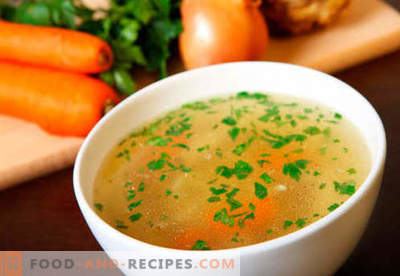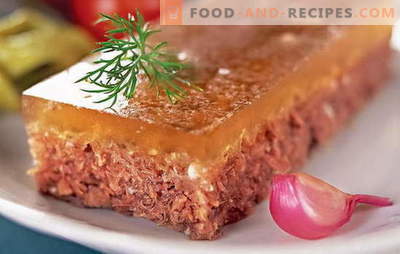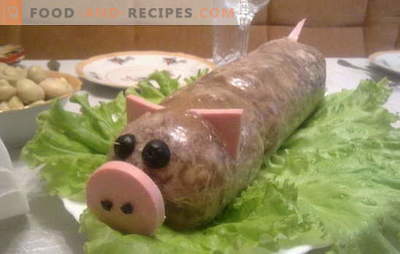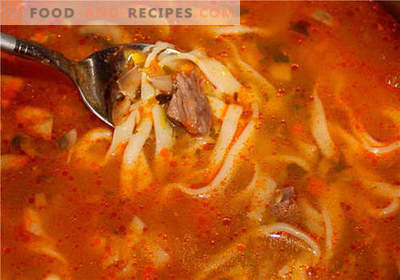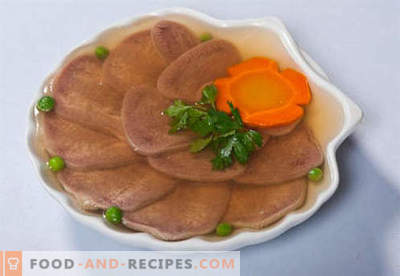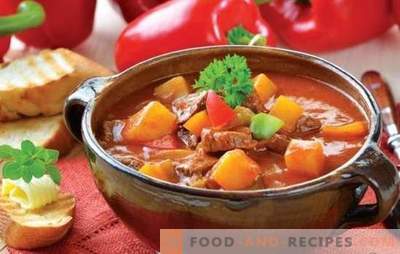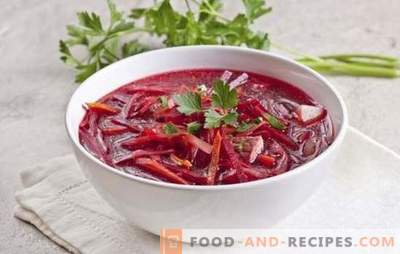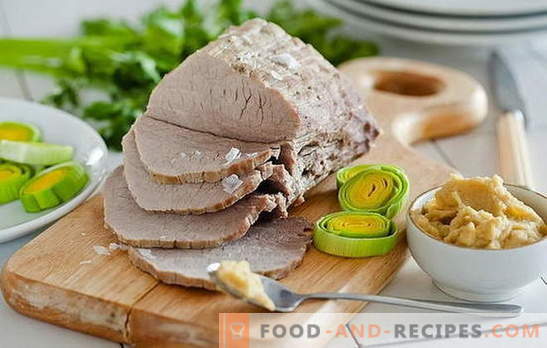
To answer the question of how much to cook beef, you first need to figure out which part of the carcass to cook.
It is even better, of course, to take into account the variety and age of the carcass, from which a piece of meat was taken.
The so-called “marble” beef, which has a significant portion of fat in the pulp, has a shorter heat treatment period than lean meat, with a more dense structure of muscle tissue.
A number of other factors influence the density and stiffness of the pulp: the age of a fighting animal, and even its gender, conditions of detention, and diet.
If there is an opportunity to clarify these issues before buying meat, then it will be much easier to cope with the heat treatment and distribute correctly which of the pieces of beef to use for frying, and which to boil or bake.
The age of the slaughter carcass affects the stiffness of the muscle tissue, and hence the duration of its heat treatment, due to the fact that in the carcasses of old animals the connective fluid in the muscle fibers contains much less than the meat of the young, which certainly affects the duration of cooking.
Young beef is cooked much faster than the meat of older animals. Muscle tissue of young meat is more saturated with connective fluid, giving juiciness and softness to meat during cooking.
Female carcasses of any type of meat have a softer structure due to the high content of fat cells in the interlayers of muscle tissue.
Feeding animals before slaughter with succulent grasses under free-range conditions also affects the taste and density of meat.
How to cook beef - the basic technological principles
Knowing these details of growing beef cattle breeds, we can begin to study the next question, revealing the secrets of proper heat treatment of beef, but from the point of view of chemistry and physics, the reaction of the protein under the influence of temperature. During the cooking process, the muscle fibers of the meat, which are proteins, are compressed already at a temperature of 40ºC and the pulp is compacted. At the same time, the connective fluid between the fibers of the protein, which is nothing more than collagen, which is converted into gluten during the cooking process and thereby ensures the juiciness and softness of the finished meat. The readiness of meat occurs when the connective fluid turns into meat juice, which has a liquid consistency, a transparent color, without a characteristic bloody color. In veal, the connective proteins are much less than in beef, so its readiness comes earlier.
It is not advisable to digest or roast the meat, as this will destroy the valuable elements contained in it. It should be noted that vitamins contained in all types of meat have a higher resistance compared to vitamins contained in other product groups.
Duration of cooking depends on the weight of the product, the degree of grinding: minced beef semi-finished products, ground beef are subjected to a shorter heat treatment than whole pieces of beef. It is impossible to specify a more specific time, in view of all the factors mentioned above, but in any case, the readiness of cooked beef is easily determined in a simple way: chop a whole piece of beef with a fork and lift it over the pan - if the meat slips freely from the fork, it is ready. The readiness of smaller pieces or minced meat products is checked organoleptically.
Before cooking the meat is washed, if necessary, separate the pulp from the bone. For the preparation of jelly and in some other cases, the meat is kept in cold water to remove blood residues, which ensures the transparency of the broth. The water needs to be changed.
As mentioned above, the process of protein denaturation begins already at 40ºC. In addition, with prolonged cooking at 65ºC beef reaches a degree of complete readiness. Therefore, when cooking, it is not necessary to bring the temperature to higher values, although to speed up the process, it is possible to initially boil water and then reduce the heat to an average temperature. This will allow not to miss the moment when it will be necessary to remove the foam before boiling the meat. Before removing the foam, it is not worth adding any spices and spices to the beef broth: roots should be added when the meat boils for some time, and put the greens and spices in the broth 5-10 minutes before the meat is cooked so that they do not boil over, the flavor is preserved in broth and managed to pass on to meat. Depending on the further processing of meat and its use in the dish, various components for cooking are selected. There are many, so it makes no sense to give them a complete list. To a greater extent, the choice of additives to beef depends on the recipe of the dish and the creative imagination of the chef.
The classic set that was used by our grandmothers and great-grandmothers: onions, carrot roots, parsley, celery, parsnip, a traditional blend of black and allspice, bay leaf.
Beef meat is used for salads, appetizers. Beef and veal prepared first courses. For broths used in soups, meat is cooked in water. For the preparation of main dishes, beef is boiled or stewed in its own juice or with a little addition of water, sauce.
How to cook beef depends largely on a specific recipe, and this question is more convenient to consider using examples of cooking some beef dishes.
Recipe 1. Jelly from different types of meat
This dish is prepared both from one type of meat, and using meat of different animals, poultry.
If pork, beef and poultry are taken for jelly, then the question of how much to cook beef is decided depending on the criteria already mentioned above, and also due to the fact that for jelly meat must be sufficiently boiled. In addition, it is taken into account that the cooking time of beef is longer than pork, due to its lower fat content, and poultry meat is added to the pan last, especially if young chickens are used for brawn. From the moment of boiling until the end of the cooking aspic takes at least 4 hours. Therefore, large beef and pork bones are first sent to the pan, which, after digestion, will release the natural gelatin (collagen) contained in them, which will allow, with its sufficient content, not to add crystalline powder for solidification.
Ingredients:
Rooster (gutted whole, whole) 2.5 kg
Beef fillet 1.5 kg
Tail beef 1.0 kg Pork knuckle, with skin 1.3 kg
Leg, pork 900 g
Bay leaf
Peeled carrots, whole 300 - 400 g
Black pepper (peas)
Onion, with peel 350 g
Allspice
Garlic 100g
Salt
Celery root 150 g (net)
Cooking:
Choose a pot in which all the meat will fit, taking into account the full volume of water, which should cover the meat 10-12 cm above the level.
Wash all meat, peel the skin, but do not cut the pieces: you need to cook them all. Soak the pork, beef and poultry separately. This is due to sanitary standards. Spread it in different containers and fill with cold water. Soak, changing the water 2-3 times and rinsing until the meat brightens and the water stops staining with blood.
Put all the meat in a large saucepan, cover with water to measure the amount of fluid needed. Remove the pork knuckle, beef fillet and rooster: you need to add them later when the bones are boiled out. Remove the rising foam skimmer, trying to collect it all and very carefully. Add the rest of the meat, except the rooster. Continue to follow and remove the foam. How much to cook beef will depend on the age of the carcass at the time of slaughter: the older the animal, the more saturated the red color of the carcass. Therefore, pork knuckle and fillets should be laid taking into account these nuances: first beef, and then pork and poultry, or beef with pork at the same time, and poultry - later. Cook at a constant temperature of 65-70ºC. When the broth stops foaming, throw the washed and peeled carrot and celery roots into it. Wash the onions together with the upper husk, cut off the root part and also lower it into the pan: the top layer of onion peel will give the broth a beautiful golden color. The willingness of brawn is determined by how freely the meat is separated from the bones. When the meat is cooked, add a few peas of pepper, bay leaf and salt. Add salt to taste, but keep in mind that the dish is served cold and salt it after cooking will be impossible, and the taste of salt in cold broth is less pronounced. Turn off the stove, add the minced garlic, leave the jelly to cool to 20-25ºC. Remove the cooled meat, separate it from the bones and skin, spreading only the pieces of pulp into portions. Strain the broth to maximum transparency and fill them with meat. Place boiled carrot circles, fresh leaves of pre-washed parsley or celery into each serving of jelly, and put the plates in cold for solidification.
Important point:
At the end of boiling, make sure that the broth acquires a gelatinous consistency after cooling - take a drop on your palm or rub it with your fingers: if stickiness does not appear when squeezing your fingers, you will most likely have to add diluted gelatin, because bone collagen was not enough. It is easy to fix, while the broth is warm.
Recipe 2. Boiled beef and beet salad
Ingredients:
Beetroot, baked 300 g
Beef tenderloin 500 g
Mayonnaise 100g
Salt
Pepper
Cooking:
Wash the whole beetroot wrapped in foil and bake in the oven at 200ºC. Check the readiness by piercing it with a wooden skewer. Cool and cut into thin strips. Sprinkle the sliced beetroot with any vegetable oil so that it does not stain all the ingredients of the salad, and, stirring, soak for about half an hour in a separate container.
After boiling 1 liter of water, put the beef tenderloin washed in it, reduce the heat. If you need broth, then make sure that it is transparent - remove the foam, add roots and spices for flavor. Cool the prepared meat and cut it into the same straw as beets and combine with it. If desired, add salt and pepper. Season the salad with mayonnaise before serving.
Recipe 3. Chopped beef dumplings with steamed curd
Ingredients:
Hip portion of beef (pulp) 300 g
Egg 1 pc.
Salt 1 g
Cottage cheese (18%) 270 g
Butter 50 g
Cooking:
Meat and cottage cheese twice through a meat grinder, and, adding egg and butter, whisk in a fluffy mass. Pour water into the pan and set the grate. When the water boils, spoon for ice cream or a normal teaspoon, add the ground mass, wetting your hands in water, form balls, gently put them on the grill and steam. Garnish: boiled rice or mashed potatoes.
Recipe 4. Boiled beef puree with rice and vegetable puree
Ingredients:
Beef pulp 700 g
100 g rice
Fried onion 150g
Spices 5 g (to taste)
Melted butter 70 g
Salt 2 g
Garnish: squash or beet roe; mashed potatoes
Cooking:
Boil the beef, lowering it in 1.5 liters of boiling water. From 100 grams of rice, cook viscous rice porridge. Cut the onion and let it go until it is transparent in oil. Combine the prepared ingredients, crush them twice into a homogeneous mass, add spices and butter; once again perebite everything to a lush consistency. Form balls of 40-50 g and boil them for a couple.
When serving, pour melted butter or cream sauce with chopped greens.
Recipe 5. Chopped Beef Roll with Steamed Omelet
Ingredients:
Minced meat beef 600 g
Ready omelet 400 g
Chopped green onions 200 g
Oil, melted 82.5% 80 g
Cooking:
Put a cutlet mass on a moist silicone cloth with a layer of 1.5 cm and smooth it. Top with an even layer of omelet slices, stepping back from the edge of minced 3 cm. Cover the omelet with a layer of chopped onion. Roll the roll and lay it on the grill, seam down. Pierce in several places with a skewer and cook for a couple of 55-60 minutes. Serve, sliced and watered.
This dish is suitable for any side dish of cereals, pasta or vegetables.
How to cook beef - tips and tricks
- If boiled meat is necessary for making salad, then boil it in a whole piece to keep it juicy. When cooking, add any spices and spices to give the desired flavor to the beef, but do not salt the broth so that the salt does not draw the juice out of the meat.
- The smaller the pieces of beef, the faster they can be cooked during the cooking process.
- For cooking beef pulp, it is enough to take water 1.5 times the weight of meat: for 1 kg of fillet, 1500 ml of water. If you cook meat on the bone, in particular, if the bones are tubular, as they say, “sugar”, then the volume of water must be increased accordingly, since the bones are boiled long enough, resulting in a significant amount of water evaporated.
- It is not recommended to add water during the cooking process, as this worsens the taste of the broth. Such a reception is permissible only at the initial stage: if, for example, the moment of foam removal was missed, the addition of cold water will allow to correct the situation. It is only necessary not to miss the next boiling moment again and to remove the foam in time.
